![]() Attach
|
Attach
|
![]() Edit
|
Edit
|
![]() Revisions
Revisions
![]() Related Content
Related Content
Canon EOS Digital Rebel XTi vs. Canon EOS-1Ds Mark III
Does the name of this article sound controversial? Why would anyone compare the lowest entry-level digital camera built for consumers to the top-of-the-line flagship model built for professionals?
The Canon EOS Digital Rebel XTi is a low-cost digital SLR camera that many camera enthusiasts can afford. It's affordable entry level price will permit many folks to obtain a Digital Single Lens Reflex (SLR), without having to invest the equivalent of months of mortgage payments. Plus, its not too large and bulky to carry around much the time and it's a good stepping stone to the more advanced digital SLR camera if photography becomes a passion.
The Canon EOS-1Ds Mark III, on the other hand, is a beast in comparison. Just looking at the massive digital SLR camera causes most folks to shy away. And it's no nonsense, no frill matte body far from screams out, "look at me, I'm a digital camera!" At the cost of several time the amount of a single house mortgage payment, most folks can't even consider this camera unless their wage depends on it.
If the pro-model and entry level models have the same features, how can the price difference be justified? Pricing then, isn't everything. A good friend pointed this out to me when he asked about the difference between the entry-level and the pro-level digital camera. How would he know which one he wants or needs. So in this article, I will go into an in-depth analysis on the difference between the two ultimate models at the opposite ends of the spectrum. So, between these two digital cameras which should you buy? That is the real question, and that is why this controversial comparison makes perfect sense. For many, the question is not necessarily about whether to buy a Canon or a Nikon, but, rather, whether to buy the low-end or the high-end model.
Cost
The cost of the cameras are probably the most transparent factor. Most enthusiasts will pick the Digital Rebel XTi over the EOS-1Ds Mark III simply because of the cost. There is nothing wrong with that; we all buy what we can afford. But as I mentioned before, cost isn't everything.
At the time of this writing, you can buy a Digital Rebel XTi body for $529.65 off Amazon (see "Related Links" below). And you can buy a EOS-1Ds Mark III for $4,429.67 off Amazon (see "Related Links" below). That's a huge different. The Digital Rebel XTi is just over 1/10th the cost of the EOS-1Ds Mark III. Does the professional model warrant that much premium over the lower-end model? Let's see based on the other differences.
Megapixel
The Digital Rebel XTi has a 10.1 MP sensor. That's far more pixels than previous generation digital SLR camera; even when compared to the mid-range models. But the EOS-1Ds Mark III comes with a whopping 21.1-megapixel sensor. That's twice as many pixels as the Digital Rebel XTi.
The 10.1 MP image sensor (Left) and the 21.1 MP imager sensor (right).
Do you need that many pixels? Well, it depends on what you are doing. If you are just shooting for fun, then 10.1 MP is probably more than your needs. On the other hand, if photography is your business, more megapixels may mean more money. For example, in the stock photography world, the photograph license is sold by the image size. The larger the image, the higher the cost for the license. So for the same image, you can potentially make more in the commercial world..
Sensor Size and Magnification
The Digital Rebel XTi has a APS-C size sensor. This sensor is smaller than the de-facto standard of the 35mm film. Due to the reduction in size, using the same lens as the 35mm camera, the magnification is 1.6x greater. For example, a 50mm focal length lens becomes 80mm on the Digital Rebel XTi. That's not so bad if you started photography without ever having shot with a 35mm camera before. But if you have, shooting with 1.6x magnification will really change your shooting style. With this smaller sensor, a 20mm wide-angle lens becomes 32mm. And now wide-angle shots seems extremely difficult to obtain.
On the other hand, EOS-1Ds Mark III has a full-frame sensor. The term full-frame is used to describe a digital sensor that is the same size as the 35mm film. With a full-frame sensor camera, you shoot digitally just like you do with 35mm film. There is no need to change your shooting style. You'll be able to switch back-and-forth with your 35mm film camera and not know a difference. This is almost a necessity for professionals that need to shoot both film and digital images.
Lens
The Digital Rebel XTi can use all of the Canon EF 35mm lenses; except with a 1.6x magnification as mentioned in the previous section. In addition, it can also use Canon EF-S series of lenses. These lenses are specially designed to work with the smaller imager size. These EF-S lenses will not work on full-frame sensors. Therefore, there are more lenses to choose from for the Digital Rebel XTi. But the question is, should you buy EF-S lenses? They won't work if you ever decide to step-up to a full-frame DSLR in the future.
The EOS-1Ds Mark III can use all of the Canon EF 35mm lenses. But it cannot use the Canon EF-S lenses, because those lenses are designed for the smaller sensors. So in theory, there are less lenses to choose from for the EOS-1Ds Mark III. But so far, all of the EF-S lenses seems to be duplication the range and functionality of the EF lenses. Therefore, whether there is a need to use EF-S lenses are up in the air.
Kit
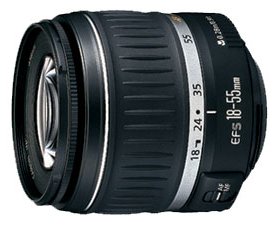
You can buy the Digital Rebel XTi in a kit, which comes with the Canon EF-S 18-55mm f/3.5-5.6 lens. It's not a bad lens to start, especially the 18mm is going to be equivalent to 28.8mm on the Digital Rebel XTi. It's probably one of the most affordable wide-angle lens you can find for the price. This combination is excellent for folks who are just getting into photography and not sure what lenses fit their shooting style. Too bad a lens hood for this lens is not included in the kit. Be sure to pick one up if you do buy the kit.
There is no kits for the EOS-1Ds Mark III. Canon assumes that the working professional already knows what lenses suits their need. That's probably true. But for someone who is just getting into photography, a bit of research has to be done in this area. (See Lens Reviews in other parts of this web site.)
Flash
The Digital Rebel XTi has a built-in flash. You can use it to brighten up your image, provide fill-flash, or just blind party people with it. Despite the joke I just made, having a built-in flash really comes in handy sometimes when you left your external flash at home. Or if you find out later that you need a fill when you didn't think you did earlier. When you are done, retract the flash and it disappears. The retractable flash is really handy and convenient.
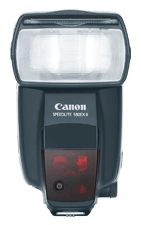
Most working professionals consider the built-in flash to be quite useless. And Canon agrees. Therefore, the EOS-1Ds Mark III does not have a built-in flash. If you want to use a flash at all, you'll need to shell out some money for an external unit, like the Canon Speedlite 580EX II. That means you will really be standing out at the next shindig. If you are just shooting for fun and you don't want to stand out in a party, you might want to consider the Digital Rebel XTi instead.
In addition, the EOS-1Ds Mark III provides a PC Terminal interface for connecting external strobes and spots. The PC Terminal interface has ability to accept sync line voltages up to 250V maximum. The built-in PC Terminal make external interfacing to studio lighting a piece of cake.
Storage
The Digital Rebel XTi stores image files to a CompactFlash Type I or CompactFlash Type II card. The EOS-1Ds Mark III can do the same, in addition, to being able to store to a SD Card in an entirely separate slot. If you want to store images to a SD Card on the Digital Rebel XTi, you'll have to get a memory card adapter (search for them on this web site).
White Balance
The Digital Rebel XTi supports the following white-balance modes: Auto, Preset (Daylight, Shade, Cloudy, Tungsten Light, White Fluorescent Light, Flash), and Manual (Custom, or user-set Color Temperature).
The EOS-1Ds Mark III supports the following white-balance modes: Auto, Daylight, Shade, Cloudy, Tungsten Light, White Fluorescent Light, Flash, five Custom WB settings (1-5), user-set Color Temperature (2,500~10,000K), five Personal White Balance PC-1 to PC-5
Viewfinder
The Canon EOS Digital Rebel XTi has a viewfinder that covers the frame approximately 95% horizontally and vertically. That means when you look through the viewfinder, you will miss 5% of the scene that you will capture in your image. The 5% is around the edge of the frame, so you can be pretty confident that your subject is going to be in the frame. When you review your photo, you might wonder why you where the extra details on the edge of the frame comes from; it's this 5% of "blind-spot".
The Canon EOS-1Ds Mark III, on the other hand, has a viewfinder with approximately 100% horizontally and vertically coverage. That means you will see everything you are going to capture through the viewfinder. The full-coverage is extremely helpful when you do copy work. Such as slide duplication, or photo-copy of fine art paintings, etc. Without this capability, you will most likely capture the slide frame, or other extraneous details that should be left out of the photo.
Auto-Focus
The Digital Rebel XTi has 9 AF points, with AF working Range of EV -0.5 to 18 (ISO 100 at 73°F/23°C). That is quite descent. But to be consistent in focusing on the right subject, use the center one for all focusing purposes, then recompose to frame the shot.
The EOS-1Ds Mark III has 45-point (19 high-precision cross-type AF points plus 26 Assist AF points), with AF working range of EV -1 to 18 (ISO 100 at 73°F/23°C). This means that the EOS-1Ds Mark III can auto-focus with less light. It's very useful in low-light situations. The EOS-1Ds Mark III has 45 focus points covering most of the frame. This coverage helps real-time tracking of the subject in motion. It's extremely helpful for sports photography.
Exposure Measurement
Most digital SLR cameras support three different method of metering exposure: 1) evaluative metering; 2) partial metering; and 3) center-weighted average metering. Evaluative metering takes the whole scene into consideration, while the camera may give special emphasize to the AF point that is in focus. Partial metering uses the center of the scene (usually around 10 percent of the entire scene) to determine exposure. And center-weight average measures the entire scene, but gives the center of the scene a much higher weight to determine exposure.
The biggest difference between a professional DSLR camera and an entry model is that the professional DSLR has spot metering. Spot metering is very much like partial meters, except it only measure a small percentage of the entire scene at the center. The EOS-1Ds Mark III has a spot meter that is approximately 2.4% of the viewfinder. It allows you to accurately determine exposure from a small object in the scene. Therefore, if you are well trained on identifying shades of color for exposure, spot metering is extremely handy and consistent.
Shutter
In the arena of shutter speed, the Canon EOS Digital Rebel XTi provides fairly fast speed of 1/4000th of a second, which is twice as fast as many previous entry-level Rebel cameras. The EOS-1Ds Mark III, on the other hand, doubles that amount to 1/8000th of a second. The extremely fast shutter speed comes in handy when you are in extremely bright conditions, where your ISO speed is at the lowest possible setting. Another use of fast shutter speed is if you are trying to freeze an object that is moving quickly.
LCD
Both cameras provides LCD's on the back-size for reviewing photos and changing settings. The Digital Rebel XTi has a 2.5" screen, while the EOS-1Ds Mark III has a 3" screen. In both cases, the image coverage is 100%.
Accessories
In the Boxes
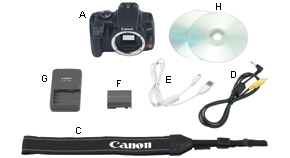
|
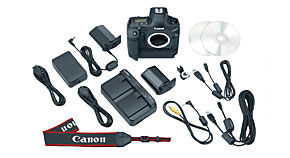
|
Style
As I mentioned before the EOS-1Ds Mark III is a no-nonsense model. Either you take it or you leave it. The Digital Rebel XTi, on the other hand, is built for your enjoyment. There are two different Digital Rebel XTi models: the black and the silver. You can literally show off your shiny new gadget with the silver model. Just keep in mind that the optional vertical battery grip only comes in black. But even with the black vertical battery grip, the silver Digital Rebel XTi still looks pretty good.
Size and Weight
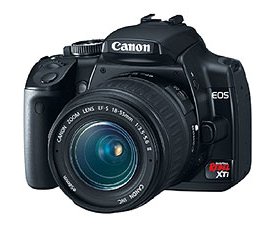
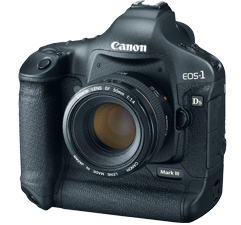
The Digital Rebel XTi is much smaller and lighter than the EOS-1Ds Mark III. It's much easier to stuff into your travel bags and backpacks. And if you do any amount of hiking, you'll appreciate the weight saving of the Digital Rebel XTi. Dimensions (W x H x D): 4.98 x 3.71 x 2.56 in./126.5 x 94.2 x 65mm. Weight: 18 oz./510g (body only).
The EOS-1Ds Mark III is almost twice as big and more than twice as heavy as the Digital Rebel XTi. With a built-in vertical battery grip, you can't even pull it off to reduce the size. And if you need a flash, which isn't built-in to the camera, you'll be packing an external flash with its own sets of batteries. The good news, like free weights, you'll increase the muscle mass of your right arm in no time. Add a professional Canon EF 600mm f/4L IS USM lens and you'll really be talking about exercising while you photograph. Dimensions (W x H x D): 6.1 x 6.3 x 3.1 in./156 x 159.6 x 79.9mm. Weight: 42.5 oz./1,205g.
Related Links
- Canon Digital Rebel XTi 10.1MP Digital SLR Camera (Black Body Only)
- Canon Digital Rebel XTi 10.1MP Digital SLR Camera with EF-S 18-55mm f/3.5-5.6 Lens (Black)
- Canon Digital Rebel XTi 10.1MP Digital SLR Camera (Silver Body Only)
- Canon Digital Rebel XTi 10.1MP Digital SLR Camera with EF-S 18-55mm f/3.5-5.6 Lens (Silver)
- Canon EF-S 18-55mm f/3.5-5.6 IS SLR Lens
- Canon EF-S 18-55mm f/3.5-5.6 USM SLR Lens for EOS Digital SLR's
- Canon EF-S 18-55mm f/3.5-5.6 II Lens for EOS Digital SLR Rebel XT, XTI, 20D & 30D Digital Cameras
- Canon EOS 1D Mark III 10.1MP Digital SLR Camera (Body Only)
- Canon Speedlite 580EX II Flash for Canon EOS Digital SLR Cameras
![]() Attach
|
Attach
|
![]() Edit
|
Edit
|
![]() Revisions
Revisions
![]() Related Content
Related Content
Attachments
- 10.1 Megapixel CMOS Sensor .jpg (9 KB)
- 1dsmark3_kitcontents.jpg (13 KB)
- 1dsmk3_586x225.gif (37 KB)
- 21.1 Megapixel Full-Frame CMOS Sensor.jpg (9 KB)
- Canon EF-S 18mm-55mm f3.5-5.6 USM.jpg (14 KB)
- Canon EOS Digital Rebel XTi.jpg (14 KB)
- Canon EOS-1Ds Mark III.gif (37 KB)
- Canon Speedlite 580EX II.gif (19 KB)
- RebelXTi_kit_contents.jpg (21 KB)
- rebel_xti_586x225.jpg (16 KB)
740 Users Online
|
$10000-above $5000-$9999 $2000-$4999 $1000-$1999 $500-$999 $200-$499 $100-$199 $50-$99 $25-$49 $0-$24 Gift Certificate |
|




